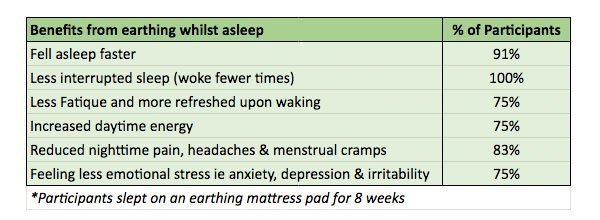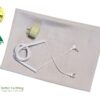Could Earthing or Grounding Improve Your REM Sleep?

During the first two weeks of earthing, some people notice that they have vivid dreams. It can be like going to the movies, but while you’re asleep.
One explanation for this increased dreaming is that your body is catching up on REM sleep or dreaming sleep.
Sleep researcher Matthew Walker says that when we accumulate a sleep debt and get the chance to catch up, the brain first gorges on deep sleep (Non-REM sleep). And then, on night two, three or even four, REM or dreaming sleep catchup accelerates. (1)
Could this be why some people have vivid dreams with earthing, especially in their first week or two?
New to earthing? Earthing is the practice of grounding yourself to the earth’s negative charge. It has many health benefits that support improved sleep (quantity and quality). Research shows that earthing can calm the nervous system, normalise overnight cortisol levels, and reduce stress. There have been over 20 peer-reviewed studies on earthing.
Why REM Sleep is Important
Sleep researchers have been studying different types of sleep and the role it plays in memory, learning, health, mood, emotion, and creativity since the 1920s.
The latest research suggests that REM Sleep plays a crucial role in:
- Integration of new knowledge. While deep sleep helps you store new knowledge, REM sleep integrates it with past experiences which can lead to new insights. (2)
- Creativity & Problem-Solving. One study found that REM sleep increases your ability to gain new insights by 50%.
- Emotion and Memory. REM sleep allows the brain to process emotionally charged and upsetting memory experiences in a neurochemically calm or safe dreaming environment. The stress-related chemical noradrenaline (norepinephrine) stops secreting during dreaming sleep. (3)
- Emotional Intelligence. Having good REM sleep helps you recognise and interpret facial expressions and emotions. (4)
What is REM Sleep?
REM sleep is dreaming sleep and it is physically distinguished by Rapid Eye Movement and faster brain activity.
During REM sleep:
- You dream (even if you don’t remember it).
- Your brain is as active as when you are awake
- Your muscles are immobilised (apart from an occasional twitch)
- But your heart rate and breathing will likely be faster. You may be running for your life in that vivid dream!
- During REM, your brain suppresses noradrenaline, providing a safe state within which to process emotions.
- Damaged cells in your brain are cleansed (autophagy) during REM sleep. Lack of REM sleep is associated with Alzheimer’s and Parkinson’s Disease.
- Together with deep sleep (Non-REM), REM helps with memory and learning.
What is NREM Sleep?
During sleep, the brain alternates between REM and Non-REM sleep.
NREM sleep or Non-Rapid Eye Movement sleep is “deep” or “slow wave” sleep.
During Non-REM sleep:
- Our brain waves are slower
- Our eyes don’t move
- Heartbeat and breath slow, which is very helpful if you have high blood pressure.
- NREM has a calming effect on our autonomic nervous system.
- In the last 2 hours of an 8-hour sleep, NREM sleep accelerates motor-skill learning. This is especially helpful for stroke recovery, who can use sleep to repair and regrow neural connections for movement skills. (5)
- The quality and quantity of NREM deep sleep degrades as we age. By our forties, we have 60-70% less Deep Sleep than when we were teenagers. By our seventies, it may be 80-90% less. Reduced sleep quality contributes to poor health, inflammation, and forgetfulness. (6) Earthing and other natural strategies can help combat this.
What is a Sleep Cycle?
During the night we cycle between REM and NREM every 90-120 minutes, moving into deeper and deeper stages of NREM, interspersed with longer bouts of REM or dream sleep.
You can see this below.

What improves REM Sleep Cycle?
- Plan to relax before bed. If you work late and are still wound up, chances you won’t sleep well. Ideally relax without a laptop, iPad, or mobile phone. Blue light from these devices can block the natural increase of the sleep hormone melatonin, needed to help us wind down and be ready to sleep.
- Fun daily exercise can positively impact REM sleep, especially if done earlier in the day and not in the 3 hours before bed.
- Do an enjoyable stress-busting activity such as meditation, yoga, being creative, journalling, or catching up with positive friends. All these can help reduce stress, which in turn can improve REM sleep.
- Throw out the alarm clock. Matthew Walkers says if you must set an alarm, do it for going to bed instead. We get our biggest boost of REM sleep during our last sleep cycle so if you want to boost your REM get to bed earlier.
- Do an Alcohol Detox. Alcohol consumption is associated with REM sleep problems. As Matthew Walker explains: ‘When the body metabolizes alcohol it produces by-product chemicals called aldehydes and ketones. The aldehydes, in particular, will block the brain’s ability to generate REM sleep.’ Light drinkers (women: up to 0.4 servings/day; men up to 0.9 servings/day) are less likely to experience disturbed sleep according to one study, however, drinkers are still at higher risk of REM disturbance over 6 years as compared to non-drinkers.
Earthing and REM Sleep
In 2011, biohacker Dave Asprey (of Bulletproof coffee fame) created a buzz when he found that earthing helped improve his REM sleep. He discovered a consistent 30-35% increase in his REM sleep when sleeping earthed, measured via a sleep tracker.
While no studies have been done yet on earthing and REM sleep, we do know that earthing can normalise overnight cortisol levels, calm the nervous system, and reduce stress, all of which help with REM and NREM sleep, and help explain Dave Asprey’s great result.
Research on Earthing
A 2004 study followed 12 participants for 8 weeks who slept on earthing bedding. All of the participants reported an improvement in sleep quality, and 90% reported falling asleep more quickly with earthing.

It also measured overnight cortisol levels.
The hormone cortisol plays several roles in the body, one of which is to assist with our sleep-wake cycle or circadian rhythm. This hormone is secreted by adrenal glands and can be measured by testing salvia (swabbing the inside of your mouth).
In a normal profile, cortisol peaks in the morning, which triggers the process of waking up from sleep, and dips in the evening to assist sleep. The study found that over 8 weeks, all participants had re-synchronised their cortisol secretion to this pattern. Having continuously raised cortisol levels is associated with increased stress, inflammation, and pain. So it may be that by normalising cortisol levels overnight, earthing can reduce pain interfering with sleep too.
Two later studies show that grounding helps calm the nervous system. As we know, ongoing chronic stress can put the nervous system into permanent flight or fight mode (sympathetic mode). Our bodies are designed to have a quick burst of flight or fight and then move back into equilibrium. Being on high alert is taxing for our mind and body, and unsurprisingly impacts our ability to have deep sleep.
During earthing, our nervous system is likely to shift from flight or fight (sympathetic) into rest and digest (parasympathetic) mode. This can be seen in two studies that used skin conductance or heart rate variability.
The 2010 study monitoring the skin conductance of 28 participants while grounding for 40 minutes found a near-immediate switch of the nervous system (within a few seconds) to parasympathetic or rest mode. There was an immediate change when the participants stopped earthing too (returning to a normal state of tension). This change was not observed for the sham-earthed group, showing conclusively that earthing does put the nervous system into calming mode.
Heart Rate Variability is an indicator of anxiety, mental load, and emotional trauma. A 2011 study measured 28 healthy participants who earthed for 40 minutes with conductive earthing patches on their palms and feet. Readings were taken using an electrocardiogram (ECG), and the results showed a reduction of excessive sympathetic nervous system overdrive, creating more calmness in the body. (8)
How to Start Earthing
Earthing can reduce stress, improve the quality of sleep, and help create conditions for quality REM sleep as detailed above.
Sleeping on an earthing bedding can help you to return to good sleeping patterns.
Research shows that even 40 minutes of using a small earthing product can help reduce stress and indirectly support sleep. One way to start is by wearing an earthing band to bed, or before you sleep.
I have been on your wrist/ankle grounding device with a long lead for a week now. I cannot begin to tell you what a difference that silly little wire has made in my heart rhythm (AFIB), sleep, breathing, gastrointestinal, total relaxation, deep sleep and dreams and healing of even the smallest injuries as well as less pain from big injuries.
Frank Roper, Toowoomba QLD
For greater comfort and ease of movement, consider a grounding underlay and/or earthing pillowcase. Having a larger earthing product with more of your body in conductive contact can give faster results, especially with a long-term sleep problem. Take a look through our product reviews or call us for help deciding what earthing products might suit you best.
Research
(1), (2),(3), (4), (6) See Matthew Walker, Why We Sleep
(5) K Herron, D Dijk, J Ellis, J Sanders, A M Sterr, “Sleep correlates of motor recovery in chronic stroke a pilot study using sleep diaries and actigraphy’ Journal of Sleep Reserach 17 (2008): 103. C Siengsukon and L.A. Boyd, ‘Sleep enhances off-line spatial and temporal motor learning after stroke’ Neurorehabilitation & Neural Repair 4, no 23 (2009) 327-35.
(7) M. Engle-Friedman and S. Riela ‘Self-imposed sleep loss, sleepiness, effort and performance’ in Sleep and Hypnosis 6, no4 (2004): 155-62.
(8) Chevalier, Sinatra ‘Emotional stress, heart rate variability, grounding, and improved autonomic tone: clinical applications’, Integrative Medicine: A Clinician’s Journal, 2011;10 (3).





